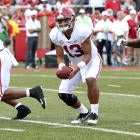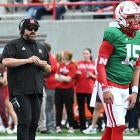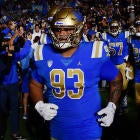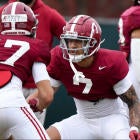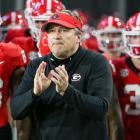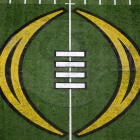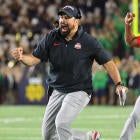KANSAS CITY, Mo. -- To get to the core of the RPO revolution that now has the NFL and college football drinking from the same cup, you have to ask a 10-year veteran backup quarterback from Michigan.
Chad Henne played four years for Lloyd Carr and was part of two Rose Bowl teams. All that bears little resemblance to the high-flying circus conducted by his current coach Andy Reid and breakout teammate Patrick Mahomes.
Told that some college coaches are now studying Kansas City Chiefs offensive tape for pointers, Henne was a bit astounded.
"Nowadays it definitely would surprise me because I feel like we're stealing from them," Henne said. "We're running some pretty good stuff."
The stuff to which he is referring is not original to either the NFL or college games in recent years. But RPOs -- run-pass option concepts -- continue to be revolutionary. It is the offense of choice for at least 50 percent of college football teams, Ole Miss offensive coordinator Phil Longo estimated last summer.
Bits and pieces of it are at least sprinkled throughout the pro and college games. On the edge of the college revolution is one Nick Saban.
"I think it's more exciting," Alabama's coach said. "I think it's why more points are scored."
This is from the coach who built his career on steak and potatoes: running the ball and playing defense. But it's easy to change your mind when Heisman Trophy frontrunner Tua Tagovailoa falls in your lap.
"You've got to kind to change the way you coach," Saban said.
An RPO begins with a quarterback having the option to run, throw or hand the ball off. Reading a defender before (pre-snap) or after (post-snap) the ball leaves the center's grip, the quarterback makes his decision. Offensive lines are run blocking, which gives the illusion of a rush no matter what is option is chosen.
A Run-Pass Option (RPO) is a called run play with a pass option. It can be a DE, a LB, or just a specific alignment the QB is looking for. The OL blocks for the run the entire way, and the QB makes a decision pre or post snap (depending on which variation is called) to run/throw. https://t.co/Uf0Uev7KHb
— Mitchell Schwartz (@MitchSchwartz72) February 4, 2018
Its roots can be traced to ancient Wing T, option and wishbone concepts. Its simplicity and deception are what make it so popular.
"One thing we always say, 'You're never wrong for what you do,'" Chiefs offensive coordinator Eric Bieniemy said of Mahomes. "We don't want him second-guessing. Go play fast, we'll correct it on the sidelines and keep forward."
When the quarterback reads that defender, it is meant to put that defensive player in "conflict" whether to play pass or run. You can see here how Tagovailoa did it brilliantly on Alabama's first touchdown against LSU.
Bama looked to have ran a third level RPO on their first TD. The WILL was blocked which meant Tua was likely reading the safety.
— Ted Nguyen (@FB_FilmAnalysis) November 4, 2018
Greedy doesn't give much space to WR but Tua accuracy trumps great coverage. pic.twitter.com/nQkjhVPdvj
"Watching Tua, he's a freak," said Rich Rodriguez, one of the founding fathers of the zone read offense that birthed RPOs. "Not only how accurate he is but how quickly he sees it and gets rid of it in an RPO. The ball is out of his hand and into another guy's hands in a second. The best quarterbacks are the point guards who can shoot the three, leading the fastbreak [and] getting rid of the ball at the right time."
Along with Rich Rod, Washington State coach Mike Leach is considered one of the forefathers of the RPO when he brought his Air Raid offense to Oklahoma in 1999.
Now, Leach sees RPO concepts in the pros "all over, especially New England, Philadelphia and Green Bay. I never thought the Steelers would fall because they're the ultimate run team. Now the Steelers are running that stuff, too."
This is no surprise. Chip Kelly came and went in the NFL bringing his zone-read concepts the league. The Eagles won the Super Bowl last year -- under Kelly's successor Doug Pederson -- going RPO-heavy. The team they beat, the Patriots, have been using college concepts for years.
With Mahomes, the Chiefs have taken RPO possibilities to the next level. Blessed with the smarts, arm and coach (Reid), Kansas City leads the NFL in passing and scoring.
Asked how it all of it happened so fast, Reid said of Mahomes, "He's got a few reps under his belt from the college game."
Yeah, just a few. Reid is speaking of Mahomes' three-year career at Texas Tech during which he threw 857 times for more than 11,000 yards. Last year, Reid and the Chiefs front office traded up to get the quarterback with the No. 10 pick in the 2017 NFL Draft, eyeing the same type of production.
The return on investment has been swift. In his first year as a starter, Mahomes leads the NFL in touchdown passes.
"He never got the credit in college he deserved because our record wasn't good enough," said Texas Tech coach Kliff Kingsbury. "He is a phenomenal talent. Everybody is going to see that on the national stage now."
It has come full circle with the NFL mimicking the best of college RPO concepts -- and vice versa.
"I watch [Chiefs] tape all the time," said North Texas coach Seth Littrell. "Mahomes is talented. I didn't know how he'd do mentally coming off a college offense."
He knows now. Los Angeles Rams quarterback Jared Goff came from a similar scheme at Cal under Sonny Dykes
"You look at two of the top teams in the league -- the Rams and the Chiefs -- their quarterbacks both came from [three and] four years starting in spread offense in a so-called gimmicky offense," Kingsbury said. "They're both going to be Pro Bowl quarterbacks and in the discussion for league MVP. I would hope that 'gimmicky' label has gone away."
Narrower hash marks in the NFL allow the field to be spread even further across than college. That made Mahomes' left-handed throw against the Broncos a possibility. (He's a righty.) His sidearm throws are real, and they're spectacular. https://www.chiefs.com/video/patrick-mahomes-diving-throw-results-in-16-yard-gain
"There are no boundaries except the sideline," Reid said. "There's a big challenge for the defense. You saw at it at the high school and college level. Now you see it at the NFL level. You've got to make sure you cover all the zones."
Tagovailoa is Mahomes' college equivalent at the moment. They have become rock stars to their fan bases. Mahomes is a like a fifth Beatle in this city creating a fashion stir when he was spotted wearing "jorts" at a car race.
A local hospital basically paused when Mahomes walked through its lobby after visiting patients in September.
In a recent conversation with CBS Sports, Saban compared Tagovailoa's "it" factor to Drew Brees and Joe Montana. Tagovailoa's ability to read and react, throwing defenses off balance even for just a second, has made this the best offense of the Saban era, which in turn may make it Saban's best overall team.
Like Mahomes, Tagovailoa has been the tip of the spear in what has become a lethal offense. The difference being Reid has long been one of the NFL's best offensive minds. It has been only in the last four years that the conservative Saban has embraced what is now a pass-first offense.
The latest twist: Tagovailoa threw a career-high 42 passes in his biggest game this season against LSU, the only one in which he's played into the fourth quarter.
"There's no chance of getting complacent in a place like this, an environment like this," Tagovailoa said. "You're surrounded by really, really talented guys. … It's moreso [that] you're forced to go out there and compete."
It was only three years ago that former Arizona Cardinals coach Bruce Arians said spread quarterbacks were "light years behind" their NFL counterparts.
It seems that you're behind, Bruce.
"I think there was a generational change," Leach said. "Some the older guys retired."
"I find it comical in the so-called 'pro-style' you'd have to be under center," Rodriguez said. "Now the NFL is 75 percent in the shotgun."
Thirty years ago, Rich Rod basically invented a lot of the stuff you're watching today when he started out at Division II Salem University. He knows that NFL RPOs are more limited than their college counterparts because pro coaches aren't going to risk running their quarterbacks. For the most part.
"Mahomes will throw the ball from all different angles," Rodriguez observed. "Most throws that are thrown awkward, you're getting away from somebody on the run. Teaching a quarterback to make awkward throws is as important as anything."
In the case of Tagovailoa and Mahomes, it looks mostly like instinct.
"I can teach a third-grader to take a three-step drop in five minutes," Rodriguez said. "But to throw without the laces [in your hand] in an RPO? That's a skill."
It takes a village of brilliant minds. In the NFL, that buffer for offensive linemen to be downfield when a pass is thrown is 1 yard. In college, it's 3 yards.
"Put it this way," Bieniemy said of fitting RPOs in that small window, "the refs do a great job of forcing you to stay because they're obviously looking for it."
Kingsbury countered, "The NFL referees aren't accustomed to seeing it. I don't know how strictly they're calling it as far as the 1-yard barrier."
"You can't necessarily just call a run play and then throw it 15 yards down the field," Mahomes said. "You have to make sure the line knows that there is a chance of throwing the ball."
A perfectly run RPO defined the 2013 college season: Auburn's Nick Marshall's game-tying touchdown pass to Sammie Coates in the Iron Bowl.
Marshall slid down the line to the left side giving defenders the impression he could do either on a run-pass option. Marshall then launched a 39-yard catch-and-run pass to Coates that tied the game with 32 seconds remaining.
At least one Auburn lineman can be seen more than 3 yards beyond the line of scrimmage.
"They had to review whether he was across the line of scrimmage," Saban recalled. "It's hard on defensive players. When do you react? It changed the game dramatically."
It may have changed Saban's mind.
Two divergent RPO plays have had a major impact on this college season.
During an upset bid at Clemson in September, Syracuse quarterback Eric Dungey completed a fourth-and-1 pass to tight end Aaron Hackett near midfield. The fourth-quarter connection was good for 19 yards and sustained a drive with the Orange leading 23-20.
But out came a flag for illegal man downfield. Offensive tackle Cody Conway was judged to be more than 3 yards downfield on the passing play. With the penalty applied, Syracuse was forced to punt, lost momentum and eventually dropped the game 27-23.
"Most of the time, those [penalties] just don't get called," redshirt senior offensive tackle Koda Martin told reporters. "The passes happen quickly, and it's difficult to tell if anybody's really downfield. ... It's just kind of an occupational hazard. It comes with the play."
West Virginia essentially beat Texas twice with a pair of RPO-influenced two-point conversion plays.
The first -- a slant from Will Grier to David Sills -- was negated by a late timeout call from Texas. The second featured Grier running over the left side for the game-winner with 16 seconds left.
West Virginia's former coach could have been smiling seeing his handiwork on display.
"I've been a head coach for 25 years. That's where most of my experience is," Rodriguez said. "The NFL is bleeding into college schemes."
And vice versa.












